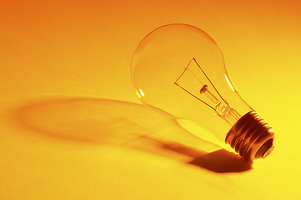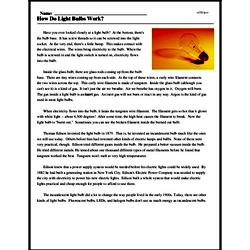How Do Light Bulbs Work?
Have you ever looked closely at a light bulb? At the bottom, there's the bulb base. It has screw threads so it can be screwed into the light socket. At the very end, there's a little bump. This makes contact with the electrical wires. The wires bring electricity to the bulb. When the bulb is screwed in and the light switch is turned on, electricity flows into the bulb.
Inside the glass bulb, there are glass rods coming up from the bulb base. There are tiny wires coming up from each side. At the top of these wires, a curly wire filament connects the two wires across the top. This curly wire filament is made of tungsten. Inside the glass bulb (although you can't see it) is a kind of gas. It isn't just the air we breathe. Air we breathe has oxygen in it. Oxygen will burn. The gas inside a light bulb is an inert gas. An inert gas will not burn or react in any way. Argon is the kind of gas used in most light bulbs.
When electricity flows into the bulb, it heats the tungsten wire filament. The filament gets so hot that it glows with white light -- about 4,500 degrees! After some time, the high heat causes the filament to break. Now the light bulb is "burnt out." Sometimes you can see the broken filament inside the burned out bulb.




